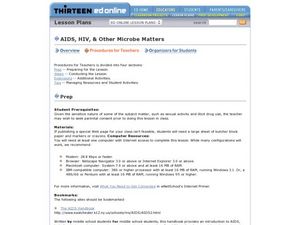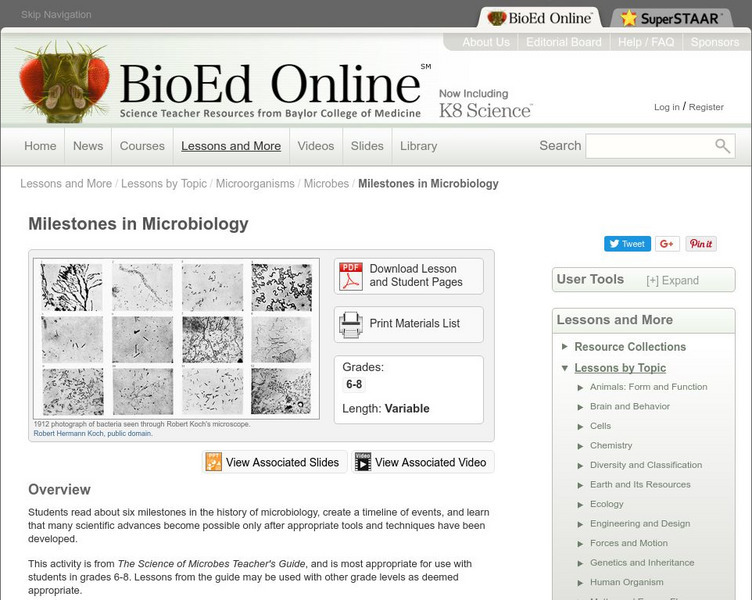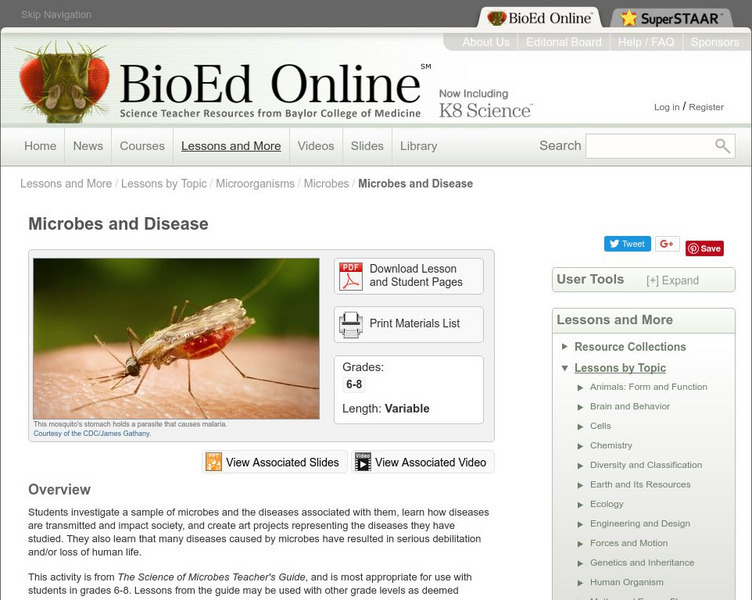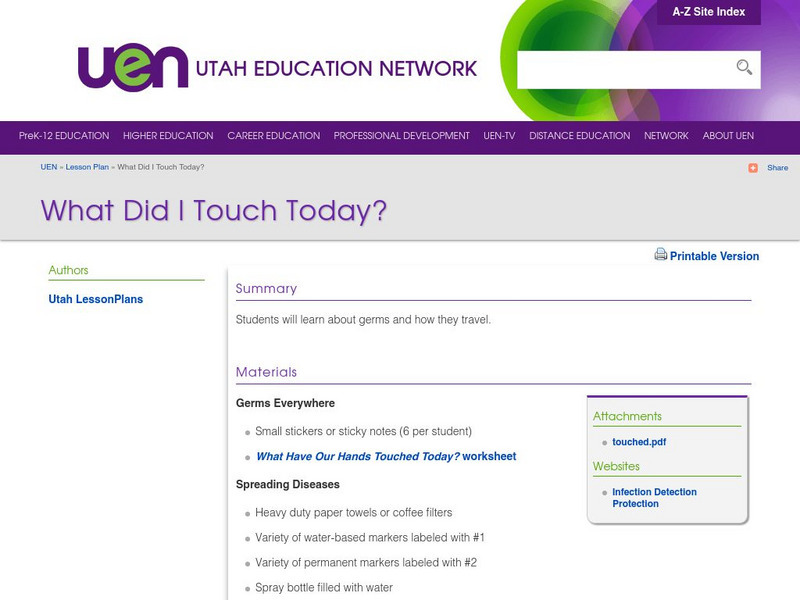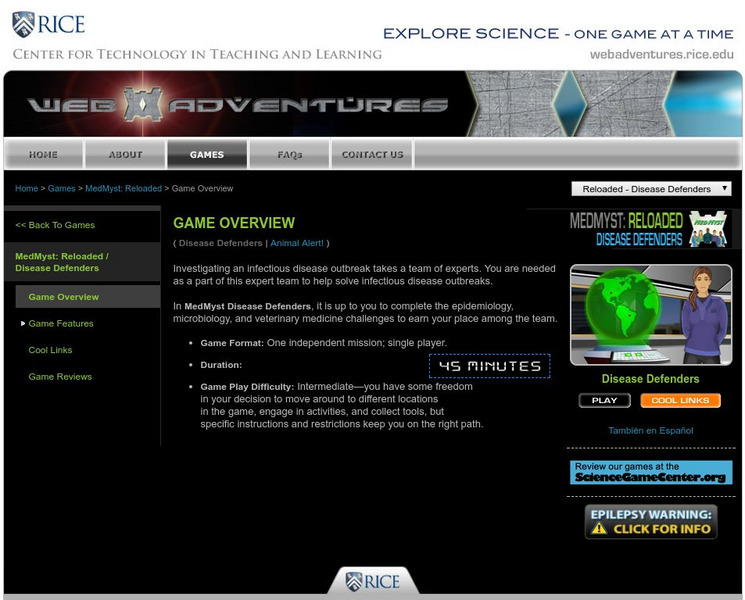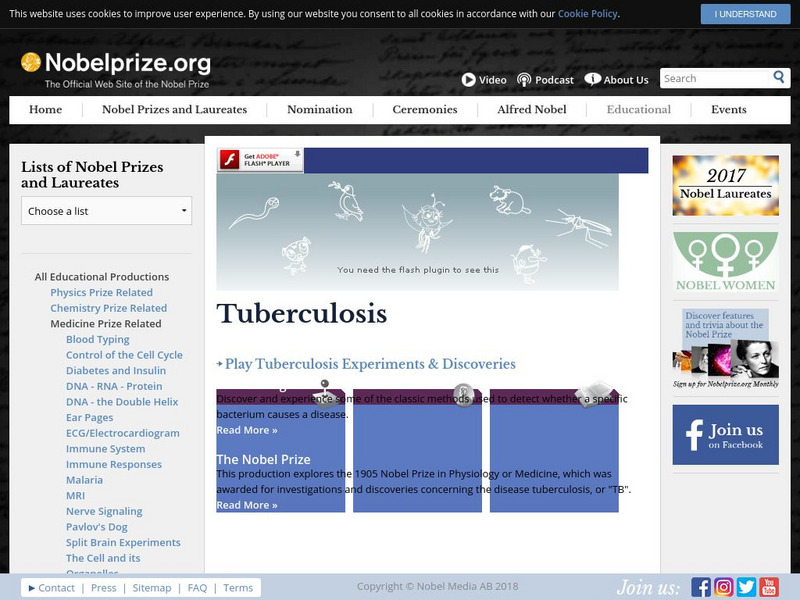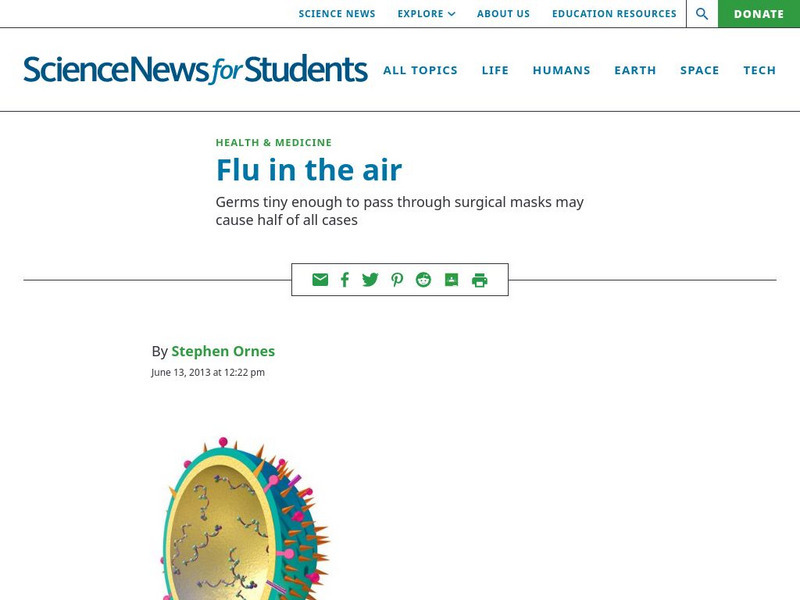Baylor College
Making Copies of an HIV Particle
In the second of five lessons about HIV, discover the mechanisms that allow the HIV virus to replicate. Using the models that they created the day before, learners examine the parts of the virus particle. The lesson plan does not say...
Curated OER
Background of Diseases-- Germs or Genes?
Students explore the background of common diseases. In this personal health lesson, students research causative agents of communicable and non-communicable diseases. Students use their research findings to create data tables in Microsoft...
Curated OER
AIDS, HIV and other Microbe Matters
This series of lessons contains sensitive material. Please review to ensure that the content is suitable for your class. It begins by discussing what microbes are. Scholars are then asked to review a few online resources and answer...
Curated OER
Diseases You Can Catch
In this communicable diseases worksheet, students research 26 diseases and determine which are caused by viruses and which are caused by bacteria. After researching, they complete 11 short answer questions about signs and symptoms of...
Curated OER
Communicable Diseases
In this communicable diseases activity, students explain what causes most types of diseases. Then they describe the difference between a disinfectant and an antiseptic. Students also determine ways that communicable diseases can be spread.
Curated OER
Soap Smart, Healthy Fun
Seventh graders investigate the scientific methods of testing the effectiveness of soap use against germs. They study the history and chemistry of soap as it has helped control the spread of germs. They make bubble soap.
Rice University
Rice University: Web Adventures: Medmyst: Reloaded: Animal Alert
In this online adventure game, players learn about a mysterious disease that is affecting people in a distant tropical region. Players can choose to role-play as an epidemiologist, microbiologist, or veterinarian to solve infectious...
BioEd Online
Bio Ed Online: The Science of Microbes: Milestones in Microbiology
Students read about six important discoveries in microbiology and put them on a timeline. They develop an understanding of how these discoveries connect to the invention of new scientific tools and technology. The instructional activity...
BioEd Online
Bio Ed Online: The Science of Microbes: Microbes and Disease
Students learn about six diseases caused by microorganisms. A video that looks at the impact disease has had on human history and society is provided. Students work in groups to read information about one disease, then share what they...
BioEd Online
Bio Ed Online: The Science of Microbes: Infectious Disease Case Study
In this activity, young scholars analyze a child's symptoms to determine whether she has a cold, the flu, strep throat, or a nasal allergy. They also learn the differences between viruses and bacteria. The lesson and a set of PowerPoint...
Utah Education Network
Uen: What Did I Touch Today?
In this instructional activity, young scholars will assess what items in the classroom are touched the most. Students will investigate germs and distinguish between communicable and noncommunicable diseases.
World Health Organization
World Health Organization: Emergencies Preparedness, Response
This reference source provides directions for emergency preparedness and how to respond to emergencies.
Rice University
Rice University: Web Adventures: Med Myst: Reloaded: Disease Defenders
In this online adventure game, become part of a team of experts investigating an infectious disease outbreak. Learn about the science of infectious disease and the medical careers of real scientists such as an epidemiologist,...
Nobel Media AB
The Nobel Prize: Tuberculosis
Play a game to learn how Dr. Robert Koch discovered tuberculosis' cause. You'll "discover and experience some of the classic methods used to detect whether a specific bacterium causes a disease."
BioEd Online
Bio Ed Online: Flu Basics
This resource provides a basic primer on the the three types of influenza and their properties. In addition, suggestions are given on health habits to practice to avoid getting the flu.
Society for Science and the Public
Science News for Students: Flu in the Air
Article reports on the recent findings that tiny particles known as aerosols are responsible for most flu infections. Includes a vocabulary list of words from the article.
McGraw Hill
Glencoe Biology: Infectious Diseases: Self Check Quiz
A five question multiple-choice quiz over infectious diseases. After answers are submitted, students have the opportunity to review the missed questions.
Annenberg Foundation
Annenberg Learner: Disease
Do you the factors that cause a disease to spread? In this simulation, figure out how to counter the spread of diseases!
WebMD
Web Md: Lice
This article from WebMD provides a great, brief overview of lice, focusing on the three main kinds. Head lice, pubic lice and body lice, each of which come with a picture. Topics that are also covered include cause, symptoms, what...
Other
Frequently Asked Questions About Head Lice
This HeadLice.org site has several links to FAQ's about head lice and also its treatment.
TED Talks
Ted: Ted Ed: Why Is Meningitis So Dangerous?
Melvin Sanicas examines how Meningitis affects our bodies.
National Institutes of Health
Aid Sinfo: Hiv/aids: The Basics
One-page overview that provides basic facts on AIDS/HIV. Learn what it is, how it is transmitted, and what the treatment is.
Other
What Is Immunization?
A general description of what vaccines are and how they work. Easy to understand.
Kenyon College
Kenyon College: Lepers
A brief overview of leprosy including a definition, characteristics, treatment, and other issues.




